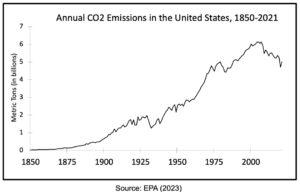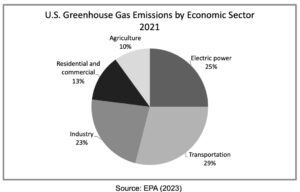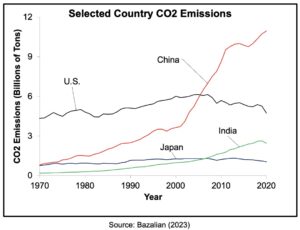Humans’ increased production of greenhouse gasses appears to be a contributor to global temperature changes. One solution is to reduce the amount of greenhouse gasses released each year, a process known as decarbonization. In this brief, we describe where greenhouse gasses come from and consider what changes could significantly reduce emissions.
What is decarbonization?
Decarbonization refers to transitioning a nation’s economy from relying on fossil fuels (coal, oil, and natural gas) to using clean (carbon-free) energy from sources such as solar, wind, hydropower, and nuclear.
Our brief on climate change discussed the logic behind decarbonization. Analysis of climate models ties higher global temperatures to increased emissions of greenhouse gasses such as carbon dioxide (CO2). These models predict that a large enough reduction in greenhouse gas emissions will eventually stabilize or could even reduce global temperatures.
How much CO2 is produced in the U.S. each year?
According to studies it’s believed the U.S. produced over 6 billion metric tons of CO2 in 2021. Some CO2 is used in industrial processes or injected into oil and natural gas wells to stimulate production. Reforestation projects also reduce CO2 emissions as trees use CO2 to grow and incorporate it into their trunks and branches.
The chart below shows the estimated annual net amount of CO2 released into the environment by U.S. individuals and businesses.
The amount of greenhouse gasses released by the U.S. has declined in recent years because of declining coal use to generate electricity and increased use of solar and wind power. However, as we discuss later, emissions from developing nations, including India and China, are increasing.
What activities produce greenhouse gasses?
The chart below depicts the percentage of greenhouse gas emissions from different economic sectors in 2021.
The figure shows that transportation, including automobiles, aircraft, and trucks, is the largest producer of CO2. Electrical power generation is a close second, followed by industrial processes, including manufacturing. For example, one of the largest single contributors to CO2 emissions is the production of concrete and cement, which accounts for about 7% of total emissions.
The important message from this figure is that there is no one solution for decarbonization. Changing how cement is made will reduce CO2 emissions from these factories, but reducing CO2 emissions from automobiles will require a completely different approach.
How far can Americans decarbonize?
The official goal of the current U.S. government is to reach “net-zero” emissions by 2050. Net zero means that whatever greenhouse gasses are produced in the U.S. are offset by CO2 removed from the environment by carbon sequestration, including biological activities such as tree planting. For details, see our brief on carbon sequestration.
Is this goal achievable? The answer depends on how much Americans are willing to pay and how much they are willing to change their lives. Some changes are already underway. Utilities are reducing emissions by closing coal-fired power plants and replacing them with renewable systems (wind, solar, and hydropower). Some factories are installing scrubbers that capture CO2 as it is produced so it is not released into the environment. Increased use of electric (and hybrid) cars and trucks also reduces total CO2 emissions.
Larger reductions to reach net zero will require more substantial and costly changes. For example, it is possible to eliminate greenhouse gas emissions from electricity generation by transitioning to renewable systems. However, as discussed in our brief on renewables, this transition will require a large investment in energy storage technologies such as batteries, mining of natural resources such as Lithium, and comes with other implications in areas like global trade and national security as other countries rely on fossil fuel exports from the U.S. and neighboring countries. Similarly, mandating electric vehicles to reduce emissions further will require building charging infrastructure nationwide and in individual homes. For details, see our brief on EV infrastructure.
Some changes are impossible with current technology. For example, our system of intercontinental air travel relies on jet engines that burn fossil fuels. There is currently no alternate fuel that can power large aircraft across long distances.
Given the practical impossibility of eliminating CO2 emissions, the net zero goal will require large-scale carbon sequestration. However, as discussed in our carbon sequestration brief, current systems that remove CO2 from the air are expensive, complicated, and have limited capacity. Moreover, plans to plant billions of trees to capture carbon dioxide require substantial land and may not capture enough carbon.
For all of these reasons, achieving net-zero CO2 without new technological breakthroughs will likely require substantial changes in our everyday lives—traveling less, using less electricity to heat and cool our homes, or driving an electric car.
It is also unclear whether achieving net zero is mandatory to address climate change. Climate models confirm that increased CO2 levels are causing global temperature changes and other effects, but they are less precise in their predictions about what will happen if we achieve this goal or substantially reduce emissions but do not eliminate them entirely.
Finally, decarbonization will affect local economies in communities with large-scale coal, oil, and natural gas production. For example, over 60% of U.S. oil is produced by three states: Texas, New Mexico, and North Dakota. Moreover, nearly 74% of coal production is in five states: Wyoming, West Virginia, Pennsylvania, Illinois, and Montana. Decarbonization would likely increase unemployment and lower economic growth in these states.
Can America decarbonize on its own?
It could – but doing so might have little effect. While the U.S. is a major producer of CO2, its emissions are only a fraction of the world’s total. The figure below compares the U.S. to three other major emitters: China, India, and Japan. As the figure shows, emissions by the two developed countries, Japan and the U.S., have been stable over the last 50 years. In contrast, emissions from China and India are rapidly increasing due to population growth and industrialization.
The problem is this. Even if the U.S. gets to net zero, this effort will have minimal effect on global temperatures unless all other countries which are major producers of CO2 do the same. In addition, in much of the developing world, emissions are not stable – they are increasing. As a result, it will be much harder for countries like China and India to achieve net zero. Many developing countries oppose a global net zero goal because they cannot afford investments in clean energy technologies.
In sum, decarbonization is both a difficult engineering and political achievement. Substantial CO2 reductions will require massive investments, technological breakthroughs, and a high level of international cooperation.
Further Reading
Welton, S. (2018). Electricity Markets and the Social Project of Decarbonization. Columbia Law Review, 118(4), 1067–1138. http://www.jstor.org/stable/26419423, accessed 11/30/23.
Aspen Institute. (2019). Decarbonization. In Designing Transitions for the New Energy Economy: A Report from the 2018 Aspen Energy Week. Aspen Institute. http://www.jstor.org/stable/resrep42637.6, accessed 11/30/23.
Ladislaw, S., & Naimoli, S. J. (2020, May 12). Climate Solutions series: Decarbonizing The Electric Power Sector. CSIS. https://tinyurl.com/3sxk4yye, accessed 07/17/2023.
Sources
What is decarbonization?
Welton, S. (2018). Electricity Markets and the Social Project of Decarbonization. Columbia Law Review, 118(4), 1067–1138. http://www.jstor.org/stable/26419423, accessed 11/30/23.
Miralles-Quirós MM, Miralles-Quirós JL. (2022). Decarbonization and the Benefits of Tackling Climate Change. International Journal of Environment Research and Public Health, 19(13):7776. doi: 10.3390/ijerph19137776, accessed 11/30/23.
Francis, T. (2023). 3 reasons businesses should invest now in decarbonization. World Economic Forum. https://tinyurl.com/2wvk2mb3, accessed 07/17/2023.
Bhatt, G. (2022). Climate security and energy security must go hand-in-hand. IMF Blog. https://tinyurl.com/mvv8jbwz, accessed 07/17/2023.
How much CO2 is produced in the U.S. each year?
United States Environmental Protection Agency. (2023). Inventory of U.S. Greenhouse Gas Emissions and Sinks. United States Environmental Protection Agency. https://tinyurl.com/z3mmrrty, accessed 07/17/2023. (Chart Data)
What activities produce greenhouse gasses?
Ritchie, H., Roser, M. (2020). United States CO2 Country Profile. Our World in Data. https://tinyurl.com/3k93bhyu, accessed 07/17/2023. (Chart Data).
How far can Americans decarbonize?
United States Geological Survey. (2023). What is carbon sequestration? https://tinyurl.com/mwj8pxpb, accessed 07/17/2023.
Cho, R. (2022). What is decarbonization, and how do we make it happen? State of the Planet. https://tinyurl.com/596fsxa7, accessed 07/17/2023.
Ladislaw, S., & Naimoli, S. J. (2020, May 12). Climate Solutions series: Decarbonizing The Electric Power Sector. CSIS. https://tinyurl.com/3sxk4yye, accessed 07/17/2023.
Aspen Institute. (2019). Decarbonization. In Designing Transitions for the New Energy Economy: A Report from the 2018 Aspen Energy Week. Aspen Institute. http://www.jstor.org/stable/resrep42637.6.
Fulton, L., & Sperling, D. (2023, February 23). Zero cost for zero-carbon transportation?. UC Davis Institute for Transportation Studies. https://tinyurl.com/4mz4yd7a, accessed 07/17/2023.
Bazilian, M. D., Victor, D. G., Castro, C., Dowling, J. A., Dehghanian, P., Gençer, E., Kammen, D., Logan, J., Mauter, M., Tarroja, B., Wagner, G., Sperling, D., Fulton, L., Arroyo, V., Aultman-Hall, L., Brown, A., Goetz, M., Noland, R. B., Rubin, J., … Sachs, J. (2020). APPROACHES FOR KEY SECTORS. In E. Crete, F. Laird, C. Maddox, C. Fox, L. Barredo, G. Bruna, E. High, A. Lynch, L. Fanaeian, & J. Bettles (Eds.), America’s ZERO CARBON ACTION PLAN: The Zero Carbon Consortium (pp. 162–319). Sustainable Development Solutions Network. http://www.jstor.org/stable/resrep29197.8, accessed 11/30/23.
U.S. Energy Information Administration. (2022). Oil and Petroleum Products Explained. https://tinyurl.com/bdzdb3wu, accessed 07/17/2023.
U.S. Energy Information Administration. (2022). Which states produce the most coal? https://www.eia.gov/tools/faqs/faq.php?id=69&t=2, accessed 07/17/2023.
Can America decarbonize on its own?
United States Environmental Protection Agency. Inventory of U.S. Greenhouse Gas Emissions and Sinks. https://tinyurl.com/426c3swx, accessed 07/17/2023. (Chart Data).
Aspen Institute. (2019). Decarbonization. In Designing Transitions for the New Energy Economy: A Report from the 2018 Aspen Energy Week. Aspen Institute. http://www.jstor.org/stable/resrep42637.6, accessed 11/30/23.
Bazilian, M. D., Victor, D. G., Castro, C., Dowling, J. A., Dehghanian, P., Gençer, E., Kammen, D., Logan, J., Mauter, M., Tarroja, B., Wagner, G., Sperling, D., Fulton, L., Arroyo, V., Aultman-Hall, L., Brown, A., Goetz, M., Noland, R. B., Rubin, J., … Sachs, J. (2020). APPROACHES FOR KEY SECTORS. In E. Crete, F. Laird, C. Maddox, C. Fox, L. Barredo, G. Bruna, E. High, A. Lynch, L. Fanaeian, & J. Bettles (Eds.) (2023) America’s ZERO CARBON ACTION PLAN: The Zero Carbon Consortium (pp. 162–319). Sustainable Development Solutions Network. http://www.jstor.org/stable/resrep29197.8, accessed 11/30/23.
Contributors
Griffin Reid (Team Lead) is a graduate student in the Department of Political Science at Indiana University and holds a Masters in Political Science from Indiana University – Indianapolis. His research is in American politics, legislative institutions, and electoral behavior. He is currently Press Secretary for the Indiana Republican Party.
Zul Norin (Intern) is a senior at Vanderbilt University majoring in Economics and is expected to graduate in May 2024.
Mary Stafford (Intern) is majoring in Public Policy Analysis and pursuing a Public and Civic Engagement certificate at Indiana University. In addition to her role at Policy vs Politics, she serves on the board of directors for Monroe County Court-appointed Special Advocates and is in the process of applying to law school.
Dr. Robert Holahan (Subject Matter Expert) is Associate Professor of Political Science and Faculty-in-Residence of the Dickinson Research Team (DiRT) at Binghamton University (SUNY) where he advises undergraduate students conducting multi-year research projects on politics, ecology, and environmental assessments. His research focuses on property rights systems in natural resource settings like oil & gas drilling, wind power generation, fisheries, and forests. He holds a PhD in Political Science in 2013 from Indiana University-Bloomington, where his advisor was Elinor Ostrom.
Dr. Nick Clark (Content Lead) is Professor of Political Science at Susquehanna University, where he is also Department Head in Political Science and Director of the Public Policy Program and the Innovation Center. He received his Ph.D. from Indiana University and researches political institutions, European politics, and the politics of economic policy.
Dr. William Bianco (Research Director) received his PhD in Political Science from the University of Rochester. He is Professor of Political Science and Director of the Indiana Political Analytics Workshop at Indiana University. His current research is on representation, political identities, and the politics of scientific research.
Publication Log
Published – 4/16/24




